The 1949 Wheat Penny is a part of the famous Lincoln Wheat series that was first minted in 1909. While the face value of the penny remains the lowest denomination in U.S. currency, some of these coins, especially in higher grades or with unique characteristics, can fetch much higher prices.
Here’s a breakdown of the 1949 Wheat Penny value, depending on the grade and mint mark:
1949 Wheat Penny Value Chart
| Type | MS60 | MS63 | MS65 | MS67 |
|---|---|---|---|---|
| 1949 (P) No Mint Mark Penny Value | $2 | $6 | $22 | $2,350 |
| 1949 D Penny Value | $2 | $10 | $22 | $1,350 |
| 1949 S Penny Value | – | $6 | $20 | $225 |
History of the 1949 Wheat Penny
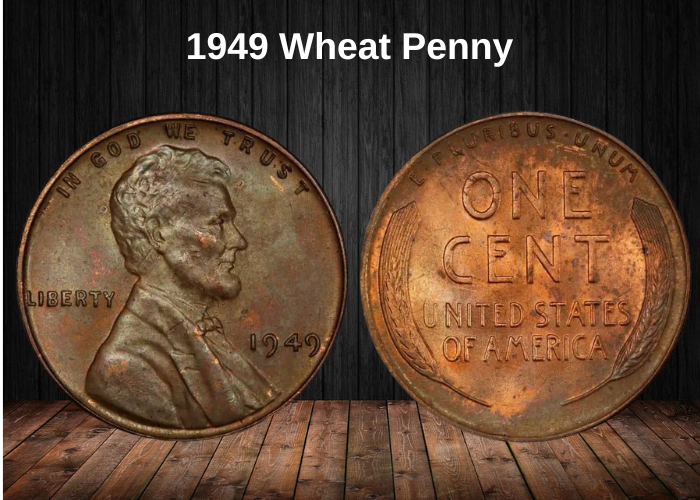
The first Lincoln pennies were introduced in 1909, marking a historic moment in U.S. coinage. It was the first time a real historical figure was featured on a U.S. coin. Previously, the idea of depicting a person on currency was associated with monarchy and considered inappropriate, but the centenary of Abraham Lincoln’s birth in 1909 led to widespread public support for this groundbreaking design.
The new Lincoln pennies became an instant hit, with people eagerly lining up to get them. These coins quickly made their way to the secondary market, where some were even sold for a quarter each, well beyond their face value. Though demand eventually leveled off, the 1909 pennies continued to fetch a premium, often selling for five times their original value.
However, the vending machine industry was not as pleased with the new design. The thickness of the coins made them incompatible with older machines, and although Charles E. Barber, the Chief Engraver of the Mint, refused to change the dimensions of the coins, it was ultimately the vending machines that had to be altered to accommodate the new pennies.
In 1936, the first proof Lincoln pennies were produced for collectors at the Philadelphia Mint, with subsequent proof issues minted in following years.
However, in 1949, no proof coins were issued, and the Philadelphia, Denver, and San Francisco Mint facilities all produced business strike pennies for circulation.
The 1949 pennies were made of bronze, an alloy of copper, tin, and zinc. This composition remained standard for Lincoln pennies, although during World War II, some pennies were made from steel to conserve copper and tin, which were in short supply due to the war. In 1943, the steel pennies with a zinc coating were produced, but this was a temporary measure, and these steel coins were discontinued after that year. Today, 1943 steel pennies are highly sought after by collectors.
Features of the 1949 Wheat Penny
The Obverse of the 1949 Penny
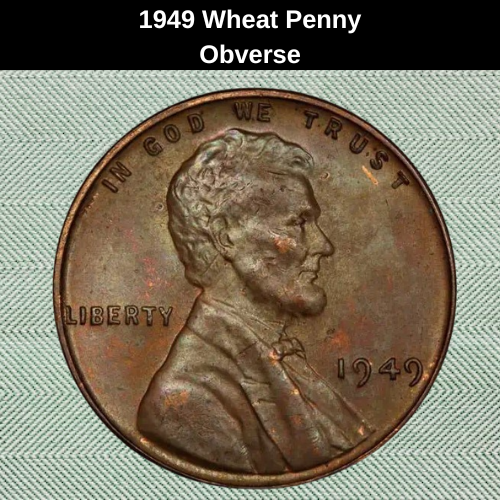
The obverse (or “heads” side) of the 1949 penny will be instantly recognizable to anyone familiar with U.S. currency. It features the familiar portrait of President Abraham Lincoln, a design that remains the longest-running design on any U.S. coin to this day.
This iconic portrait was created by Victor David Brenner, an artist originally from what is now Lithuania. Brenner, from a family of metalworkers, moved to the United States in 1890 and later studied art in Paris. His design portrays Lincoln in profile, facing right, which was meant to capture him at his most animated, as if reading to a child—a reflection of his liveliness.
To help preserve the longevity of the dies used to strike the coins, some minor adjustments were made to the obverse design in 1916. Charles E. Barber, the Chief Engraver of the Mint, smoothed out some of the wrinkles on Lincoln’s cheek and coat to reduce wear on the dies. Above Lincoln’s portrait, the motto “IN GOD WE TRUST” arches across the top, parallel to the upper edge of the coin. The word “LIBERTY” is seen to Lincoln’s left, and the date is placed further down on the right side of the coin.
If the coin was minted outside Philadelphia, the mint mark will appear below the date. 1949 pennies may have a “D” for the Denver Mint or an “S” for the San Francisco Mint, while coins struck in Philadelphia will not feature a mint mark at all.
The Reverse of the 1949 Penny
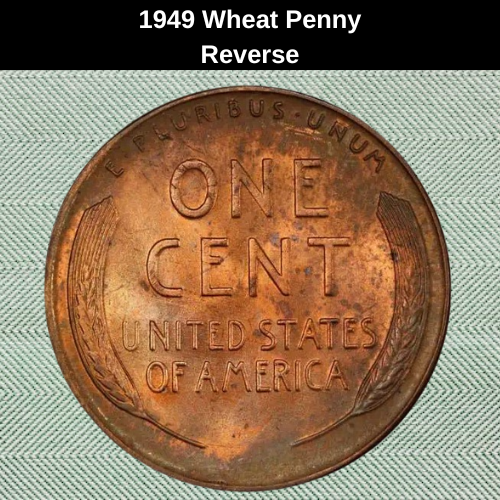
The reverse (or “tails” side) of the 1949 penny features the same design as the original Lincoln pennies. It showcases two ears of durum wheat curving up the sides of the coin, which is how the penny earned its nickname—Wheat penny.
Like the obverse, this design was also created by Victor David Brenner. However, it wasn’t his first attempt. Initially, Brenner had designed an image of a tree branch, but the Mint officials noticed a resemblance to French coins of that era and sent him back to the drawing board. They instructed him to create a more simplified design, and the two stylized wheat stalks were the result.
The wheat stalks frame the denomination, which is boldly inscribed in the middle of the coin. Just below it, in smaller lettering, is the name of the country, United States of America. At the top of the coin, curving parallel to the edge, is the Latin motto: “E PLURIBUS UNUM”, which means “Out of many, one.”
In the very first Lincoln cents, Brenner’s initials appeared on the reverse. However, the size and prominence of these initials led to criticism, with some arguing that they looked like advertising. As a result, production was halted, and the dies were amended to remove the initials.
Brenner’s initials were not reinstated until 1918, but by that time, they had been relocated to their current position on the obverse. You’ll find them subtly placed at the bottom of Lincoln’s shoulder on the front of the coin.
Other Features of the 1949 Penny
The 1949 Wheat penny shares the same composition as the majority of the Lincoln Wheat penny series, consisting of 95% copper and 5% tin and zinc. This high copper content has significant effects on the color of the coin.
If a Wheat penny is relatively uncirculated and hasn’t been exposed to much handling or oxygen, it will maintain the rich, red color typical of newly minted copper. However, over time, exposure to the air causes the coin to gradually darken to a brown color.
For collectors, red coins generally carry a higher value than brown ones, assuming all other conditions are equal. To be classified as red, the coin must meet a very specific standard: it needs to be red over at least 95% of its total surface area, including both the obverse and reverse sides. If a coin is brown for 95% or more of its surface, it will be classified as brown. Coins that fall in between the two extremes are designated as red and brown.
For a deeper understanding of how to grade Lincoln pennies and identify their color, you can check out a video from CoinOpp on YouTube, which delves into this topic in detail.
1949 Penny Grading
| Grade | Description |
|---|---|
| 1 – Basal State-1 | Severe wear, almost unrecognizable. |
| 2 – Fair | Very worn, only major details visible. |
| 3 – Very Fair | Still worn, but more details visible. |
| 4, 5, 6 – Good | Well-worn, but most features legible. |
| 7, 8, 10 – Very Good | Significant wear, but key details still visible. |
| 12, 15 – Fine | Moderate wear, features more defined. |
| 20, 30 – Very Fine | Light wear, almost all features sharp. |
| 40 – Extremely Fine | Light wear, but coin shows almost no wear. |
| 50 – About Uncirculated | Minimal wear, as if just removed from circulation. |
| 60 – Mint State | No visible wear, looks brand new. |
| 65 – Mint State | No wear, but may have minor imperfections from minting. |
| 70 – Mint State | Perfect condition, no flaws or imperfections. |
This grading scale is a key factor when determining the exact value of a 1949 penny. To get a precise value, you should check the coin’s color grade (red, red-brown, brown) and its specific grade according to the scale.
1949 Wheat Penny Value Guides
1949 No Mint Mark Wheat Penny Value
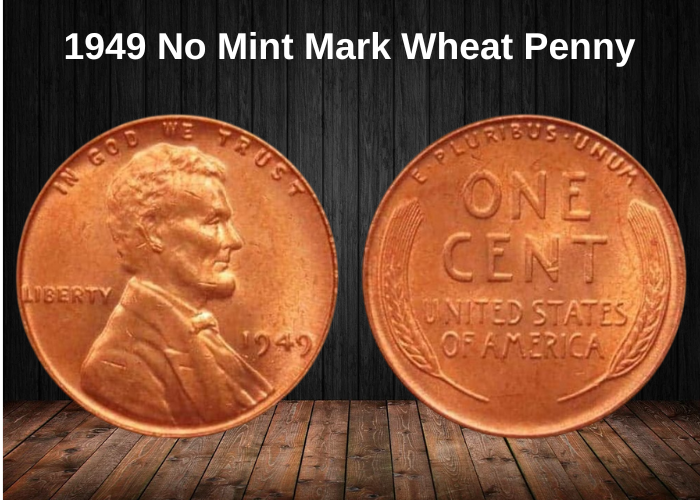
In 1949, the Philadelphia Mint produced nearly 218 million Lincoln pennies, more than any other Mint facility that year. These coins are easily identified by the absence of a mint mark beneath the date, signifying they were struck in Philadelphia.
Due to the high mintage, circulated 1949 pennies are typically worth only a few cents. Brown coins, even those in the finest condition, usually don’t fetch more than a few dollars. However, mint state coins (those graded MS60 or above, which were never circulated) can be worth more, especially if they are red in color.
Here’s how the value can vary based on the grade and color:
- Red and Brown Coins in higher mint state grades have higher value. For example, in 2012, a red and brown coin graded MS65 sold for $440, but in 2007, a similar one sold for just $19.
- In lower mint state grades, such as MS64, red pennies can be worth around $17.
- Gems (coins graded MS65 and above) are much rarer, and thus, more valuable.
As per PCGS‘s valuation:
- A red 1949 Philadelphia penny in MS64 is valued at $24.
- At MS66, the value rises to $110.
- At MS67, it jumps significantly to $2,350.
- The finest known examples of MS67+ are worth around $9,000 each.
So, while most 1949 pennies will not fetch much, if you come across one in excellent mint state condition with a red color, it can be quite valuable!
1949 D Wheat Penny Value
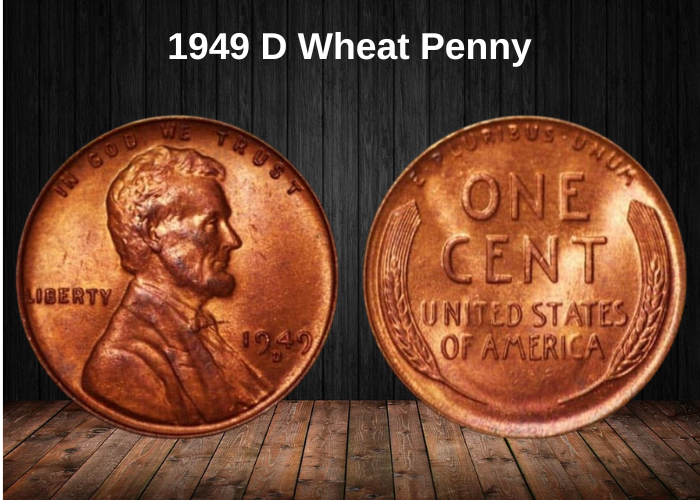
In 1949, the Denver Mint struck over 153 million pennies, making them common in circulated condition. As a result, circulated Denver pennies generally have little value and are worth only a few cents.
However, brown coins—even those in high grades—are not highly collectible. For example, a PCGS-graded MS65 BN Denver penny has been listed on an online auction platform since 2017, but despite starting at $80, it has not attracted any bids.
When it comes to red and brown coins, here’s the breakdown of their values:
- Red Denver pennies in MS60 are worth around $2.
- At MS65, they reach $22, and at MS66, the value increases to $80.
- Moving to MS67, the value jumps significantly to $1,350. There are only 71 coins certified at this grade by the PCGS.
The finest known examples are graded MS67+. The PCGS has certified just three of these coins, and they are valued at $7,500 each.
So, while 1949 Denver pennies are common, if you find one in excellent mint state with red color and a high grade, it could be worth a significant amount!
1949 S Wheat Penny Value
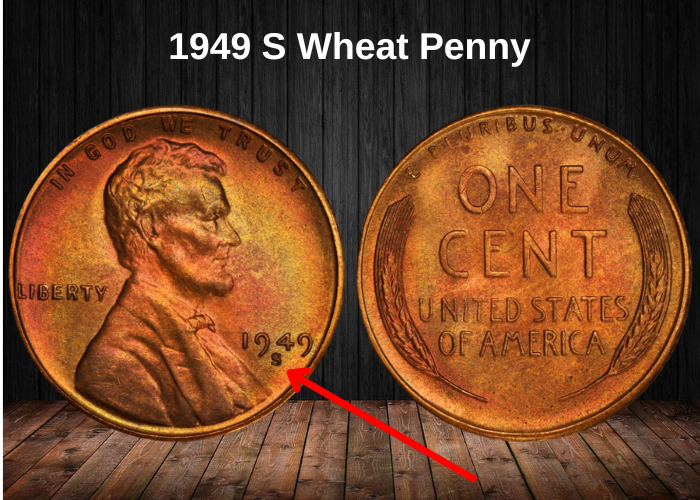
In 1949, the San Francisco Mint struck fewer pennies compared to Philadelphia and Denver, producing around 64 million pennies. These coins can be identified by the “S” mint mark beneath the date.
As with the other 1949 pennies, brown coins don’t typically command high prices. For example, in 2014, a bidder paid $60 for an AU58 (about uncirculated) example, while in 2006, a brown coin graded MS64 sold for just $16.
The sales history for mint state red and brown coins is limited, but earlier sales in 2010 show that a MS64 red coin was worth about $10, and those graded MS65 went for around $12-14.
However, 1949-S red pennies have higher values, with PCGS placing these coins at:
- $2 for MS60
- $20 for **MS65
- $225 for MS67
Similar to the other mint locations, the highest quality coins are graded MS67+, but they are more common with the “S” mint mark. The PCGS has certified 44 red pennies at this level, valuing them at $1,300 each.
So, although San Francisco pennies are more rare, their higher-grade red coins can still be valuable in the collector’s market!
Rare 1949 Penny Errors List
1949 S Penny, Double Die Obverse
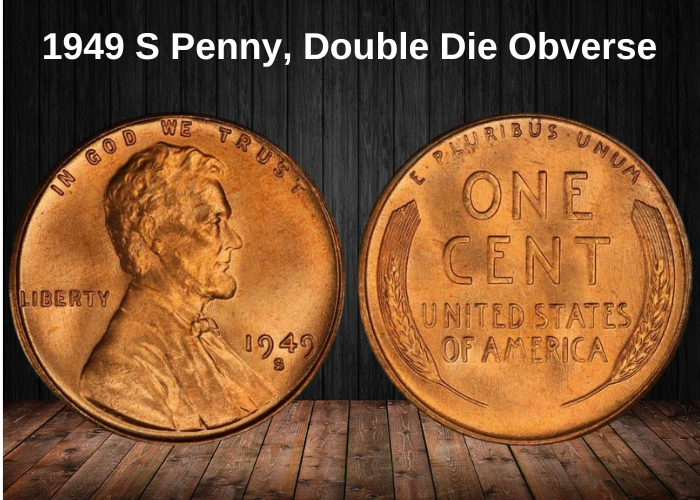
Double die errors occur when there is a shift or movement during the transfer of the design from the hub to the die. This causes a doubling effect on part of the design, which is then reproduced on all coins struck with that die.
For the 1949-S Wheat Penny, a double die error occurred with one of the obverse dies used at the San Francisco Mint. The doubling is most noticeable on the “1” and “4” in the date, but it is quite subtle, so using a microscope or loupe is recommended to see the error clearly.
The value of a coin with this error depends on its condition. The PCGS values a red 1949-S penny with the double die error at:
- $75 in MS63
- $200 in MS65
The highest graded coin with this error, graded MS67+, has a value of $1,500—$200 more than a non-error penny at the same grade.
1949 D/D, Re-punched Mint Mark
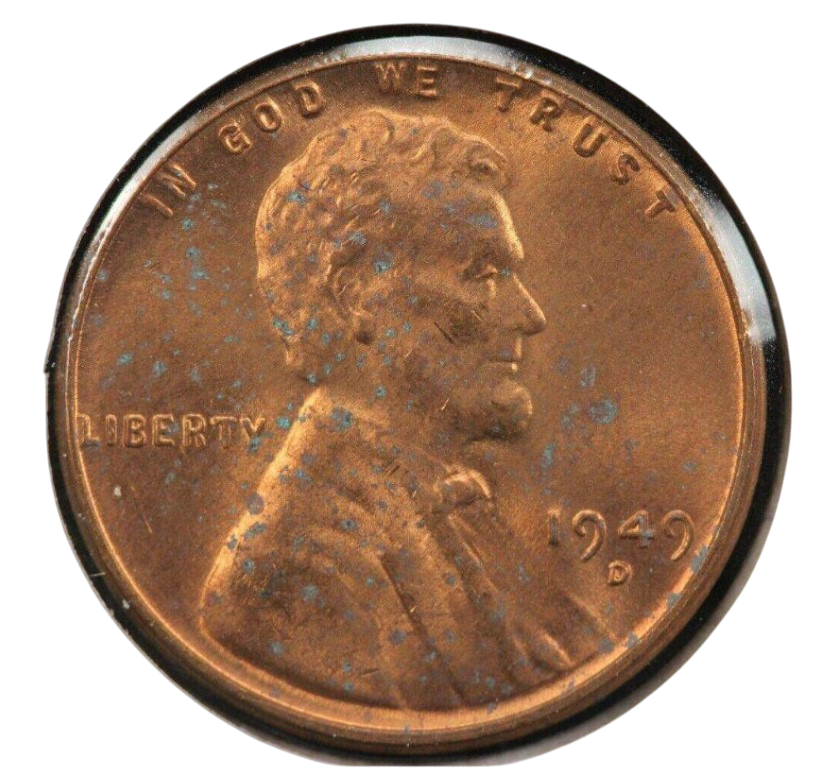
Some of the 1949 Denver pennies feature a re-punched mint mark (RPM). This error occurs when the mint mark is struck multiple times, causing it to appear slightly offset or doubled. It’s not easily visible to the naked eye, and you’ll likely need a microscope or loupe to detect it properly.
As with other errors, the condition of the coin plays a major role in its value. For instance, a 1949-D RPM penny graded MS65 red by the PCGS was auctioned for over $400.
If you’re interested in learning more about different errors in 1949 pennies, Couch Collectibles has a YouTube video that provides a detailed walkthrough.
Where to sell your penny?
Now that you know the value of your penny, you might be wondering where to sell it. Don’t worry: here’s a guide to some of the best online platforms where you can easily sell your coins, along with their advantages and disadvantages.
Discover the best platforms for selling coins online (pros and cons).
FAQ about the 1949 Wheat Penny
1. Why is the 1949 Wheat Penny important in U.S. coinage history?
The 1949 Wheat Penny holds historical significance as one of the last coins issued with the Wheat reverse design. The following year, in 1950, the U.S. Mint transitioned to the Lincoln Memorial reverse design, marking the end of the iconic Wheat motif that had been in circulation since 1909. This makes the 1949 penny an important transitional piece in U.S. numismatic history.
2. What is the metal composition of the 1949 Wheat Penny?
The 1949 Wheat Penny is made from:
- 95% copper
- 5% zinc
This was the standard metal composition for U.S. pennies between 1909 and 1942, and again from 1944 through 1949. The U.S. Mint would switch to a different composition in the 1960s, but the 1949 penny is part of the traditional copper-based alloy.
3. How many 1949 Wheat Pennies were minted?
The 1949 Wheat Penny had a significant mintage, and it is one of the more common coins in the Wheat series:
- Philadelphia (no mintmark): 1,098,000,000
- Denver (D): 282,220,000
- San Francisco (S): 119,260,000
With over 1.5 billion pennies minted, the 1949 Wheat Penny is fairly abundant, especially in circulated condition, which makes it less valuable compared to rarer coins from the series. However, high-grade or uncirculated examples can still hold considerable value.
4. What is the value of a 1949 Wheat Penny today?
The value of the 1949 Wheat Penny depends largely on its condition:
- Circulated coins: Typically worth around $0.05 to $0.25.
- Uncirculated coins: Can be worth around $1 to $10 depending on the grade (MS-63 to MS-64).
- High-grade coins (MS-65 and higher) may be worth around $15 to $30, with coins graded MS-66 or better being especially valuable, often going for $40 or more.
The large mintage means that the 1949 penny is relatively common, but high-quality specimens or those with unique errors can still fetch a higher price.
5. Are there any notable error varieties in the 1949 Wheat Penny?
Yes, like many other years, the 1949 Wheat Penny has some error varieties that are sought after by collectors:
- Double Die Obverse (DDO): Some 1949 pennies exhibit a doubled die on the obverse, especially in the areas of “LIBERTY” and “IN GOD WE TRUST”. These varieties are of interest to collectors because they feature noticeable doubled letters.
- Off-center Strikes: These coins may be struck off-center, causing part of the design to be missing.
- Die Cracks and Cuds: Some 1949 pennies show die cracks, or cuds, where part of the design was affected by damage to the die. These coins are more collectible due to their unique features.
Coins with these error varieties can have a significantly higher value, especially in well-preserved conditions.
6. How does the 1949 Wheat Penny compare to other Wheat Pennies like the 1948 or 1950?
- 1948 Wheat Penny: The 1948 penny is similar in mintage and value to the 1949 penny, but the 1949 coin is more notable due to it being the last year of the Wheat reverse design. Both coins are relatively common, but the 1949 penny is slightly more important in terms of historical transition.
- 1950 Wheat Penny: The 1950 penny marks the beginning of the Lincoln Memorial reverse design, so it has a distinct design change from the Wheat series. The 1950 penny is often considered more collectible than the 1949, as it represents a shift in the design of U.S. coins.
In terms of rarity and value, the 1949 penny is on par with the 1948 and 1950 pennies but remains somewhat less valuable due to its higher mintage.
7. How can I identify a high-grade 1949 Wheat Penny?
To identify a high-grade 1949 Wheat Penny, collectors should look for:
- Sharp, well-defined details: The wheat stalks, Lincoln’s portrait, and the inscriptions (“LIBERTY” and “IN GOD WE TRUST”) should be clear and sharp, with little to no wear.
- Minimal wear: A high-grade penny will show no wear on high points like Lincoln’s face and the wheat stalks.
- Smooth, clean surfaces: The coin should have a smooth finish with no visible scratches, marks, or tarnish. Coins that are uncirculated will show no signs of circulation and should be in mint condition.
- Luster: Uncirculated coins will display a bright luster and should shine without any surface abrasions or staining.
Coins in MS-65 or better condition with exceptional luster can command a premium from collectors.



















































